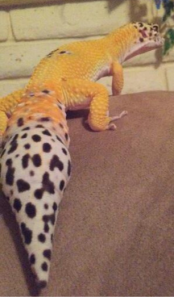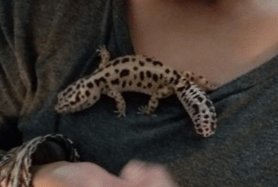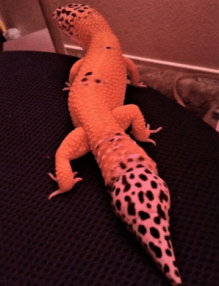Leopard geckos, and many other small lizards, have evolved to be able to lose and regenerate their tails as a form of defence. As a leopard gecko owner,what should you do if it happens to your leopard gecko?
See: Why do leopard geckos lose their tails?
If your leopard gecko loses its tail, it is important to ask yourself why this happened, and take steps to make sure it doesn’t happen again.

Perhaps you have a pet cat, who loves to sit and watch your gecko every time it leaves it’s hide? Perhaps a child accidentally grabbed the tail, or maybe you have a gecko who is nervous being handled.
It even may be the case that your leopard gecko’s tail got stuck inside something in the enclosure, thus it dropped the tail to get away, or maybe the tail could have been infected.
A leopard gecko’s tail will grow back, but losing it isn’t ideal; it is a stressful event for a gecko to lose its tail, so avoiding this happening again is very important.
Not only has your gecko perceived that it is in a life or death situation, but its fat and energy reserves are stored in the tail and will need building back up, so he/ she will need some extra TLC over the coming months.
What to do if your leopard gecko loses its tail:

You cannot reattach the tail, so find a hygienic way to dispose of it.
Find out why this happened, and try to remove the threat which caused the tail drop to happen.
Accept that your gecko’s behaviour may change, and they may hide away more than usual.
It’s really important to make sure their space is always clean (see: How often should you clean leopard geckos’ vivariums?) and has the appropriate temperatures so that your gecko can recover faster.
I do not advocate keeping leopard geckos on loose substrate anyway (see: Does sand/ loose substrate cause impaction in leopard geckos?) however this is especially important if your gecko loses a tail, as you want to avoid anything loose getting into the tail stump and prevents it from healing.

To help build up the fat in your gecko’s tail, a slight increase in fatty feeder insects can help the tail regenerate. Waxworms are ideal for this, but please make sure the rest of their diet is varied so they do not become addicted (see: Feeder insect review: Waxworms)
Keep an eye out for the stump becoming infected, and if it does, take your gecko to your nearest reptile/ exotics vet.
Make sure that they continue to shed properly, especially around their tail area.
Pay attention to your geckos needs; if they do not want to be handled, don’t force them to. They have already been through a very stressful situation, so just treat them with care and watch out for any signs that they are unwell.
Get Your Free Leopard Gecko Care Checklist!
Are you ready to give your leopard gecko the best care possible? Download our FREE PDF e-book featuring a comprehensive care checklist!
This handy guide covers everything from habitat setup to feeding and health tips, ensuring your gecko thrives.
👉 Download your checklist now!




